Review and Photos by BlueKrono and DinoToyBlog.
Struthiomimus, the ‘ostrich mimic’, was named in 1917 for a species (S. altus) originally referred in 1903 to the closely related genus Ornithomimus. Despite the history of ornithomimosaurs spanning back to the late 1800s, they are relatively rarely made as toys. This was true for all small theropods prior to Jurassic Park making Velociraptor a household name in the 1990s. Their spindly bodies make them a challenge to produce in materials robust enough to retain their shape and be played with without putting them at risk of being snapped or damaged. This was even more of a problem in the days when lanky species as Struthiomimus were restored naked, without plumage. And, since they are such small-bodied creatures, when sculpted to scale with their more gigantic relatives, small theropod toys would either end up being tiny, or companies would deviate and sculpt them in a different scale (as Invicta did when they added a small theropod to their lineup in the late 1980s). This is what makes this vintage 1961 Struthiomimus model so re-Marx-able, even by modern standards it’s impressively dainty.
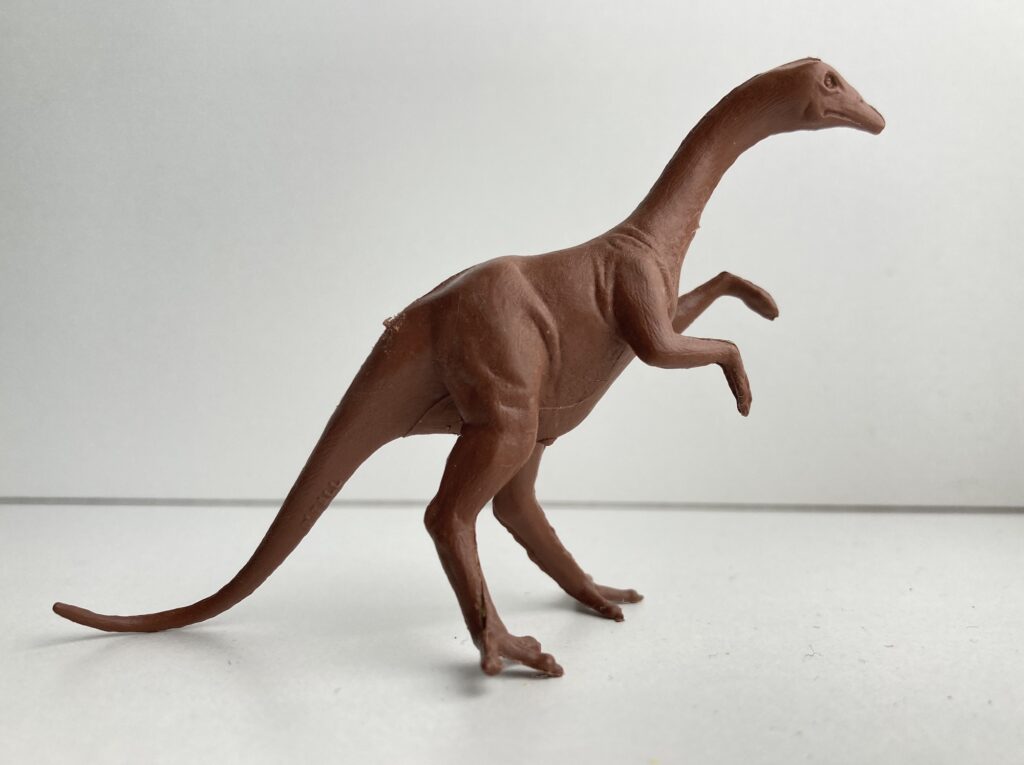
The story of the Marx Struthiomimus is intertwined with the history of another dinosaur. It begins in 1923 during Roy Chapman Andrews’ third expedition to Mongolia. Excavating rocks from the late Cretaceous, Andrews’ team discovered several new dinosaurs, including Velociraptor and Oviraptor. The Oviraptor specimen was incomplete with a badly crushed toothless skull, so its classification was open to interpretation. When it was described by paleontologist Henry Fairfield Osborn the following year it was thought to be related to the family of toothless ornithomimids, which includes Struthiomimus.
Almost four decades after the discovery of Oviraptor, the American toy company Marx was preparing to release a second group of dinosaurs following the success of their initial 1957 run. One production issue that had been noted by the time of the 1961 second series was that heavy bodied animal, such as the original pot-bellied T. rex, took too long to cool in the molds. So, the slim-bodied Struthiomimus was one of the lucky dinos selected for this run. Around this time Marx would have been looking for reference material for their Struthiomimus.
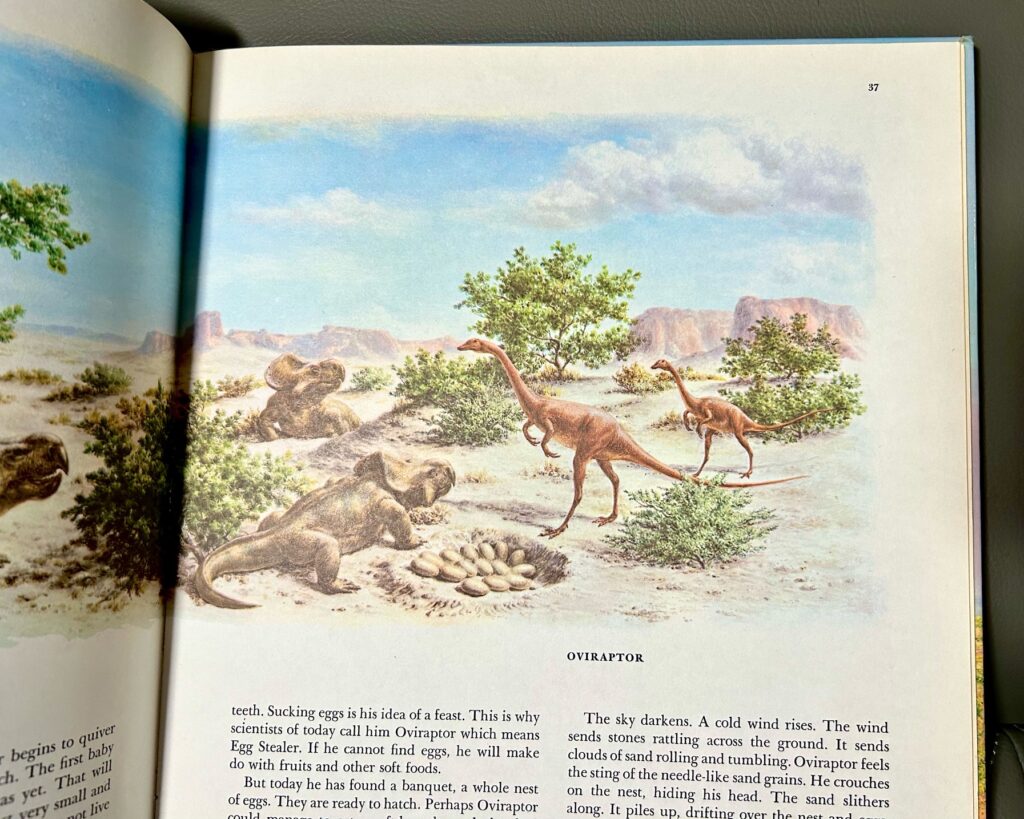
Paleoartist Rudolph F. Zallinger, more famous for his enormous murals at Yale’s Peabody Museum (more on that in a forthcoming pot-bellied Marx T. rex review), depicted Oviraptor in its ornithomimid guise in the 1960 Giant Golden Book ‘Dinosaurs and Other Prehistoric Reptiles’. It’s unknown who made the decision, Marx’s play set designer Frank Rice, or their master sculptor Phil Derham, but it seems obvious that Zallinger’s Struthiomimus-like Oviraptor restoration was used as a reference for the Marx Struthiomimus toy.
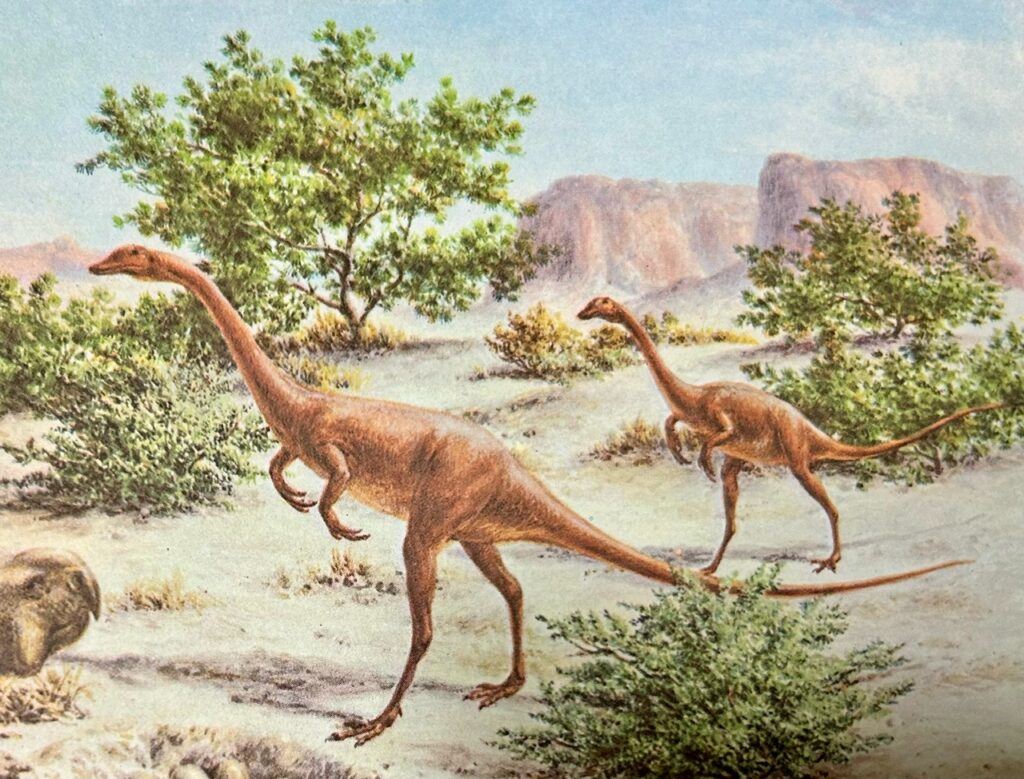
Perhaps there was a dearth of ornithomimid illustrations available in the early 1960s, so the end result came out strikingly similar, with the arms and legs only slightly more bent than Zallinger’s illustration. In the 1970s Oviraptor was eventually concluded to be quite different from ornithomimids, but by then the Marx’s Struthiomimus had already locked its place in dinosaur toy history.
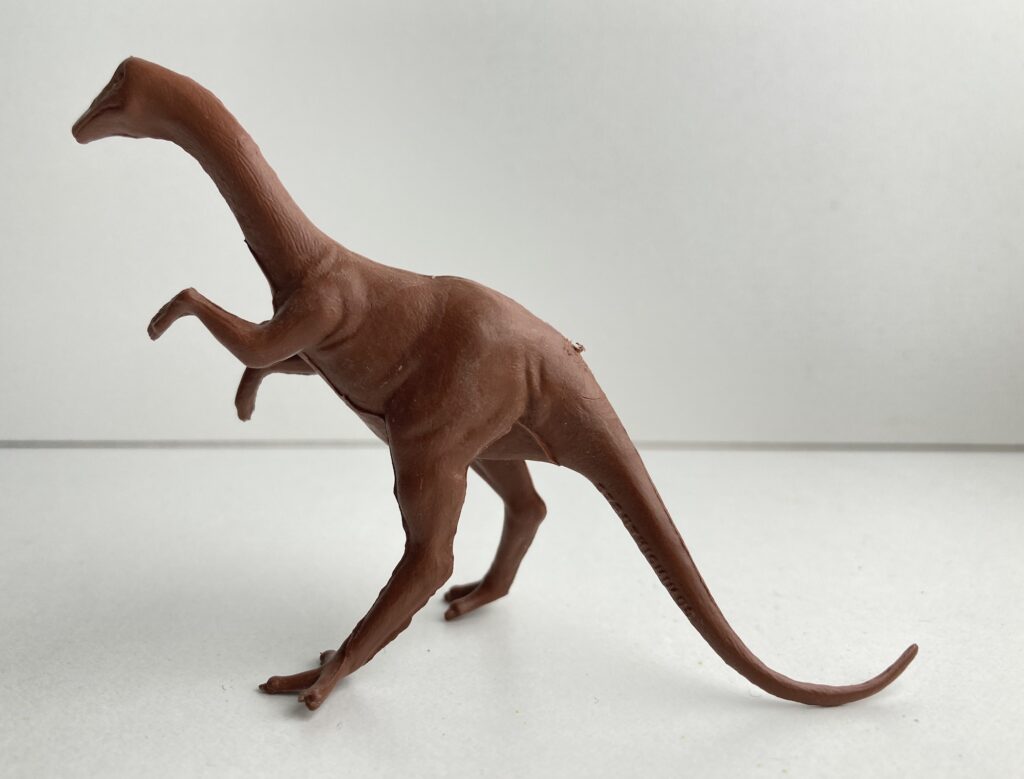
This diminutive model is 5.5 cm tall and 8.5 cm long, making it one of the smallest dinosaur figures produced by Marx. The slender build means it has very little mass. The tail, neck, legs, and toes, are incredibly narrow, yet they hold their shape. The waxy plastic lends itself well to a model like this, being both strong but flexible under pressure. The tail touches the ground to help support the figure in a tripod pose, but the stance doesn’t feel too forced as it matches early reconstructions of Struthiomimus and its relatives. Other Struthiomimus figures, such as the Tyco version from the 1980s, don’t have this excuse. The legs are splayed out and, being as thin as they are, this can lead to stability problems. Some figures, such as a relic belonging to BlueKrono excavated from the Marx Toy Dump, can’t even stand on its own anymore.

The face has an almost quizzical appearance from certain angles, with the left ‘eyebrow’ slightly raised in suspicion. But in right profile view the face is more placid, with a slightly cute bulging cheek and dimple. It is rather endearing with its confused-looking facial expression. For a figure over 60 years old this attention to detail and sense of character is an impressive achievement. The eyes are finely sculpted and the nostrils are also visible.

The feet have three individually sculpted toes, each terminating with a distinct claw. This contrasts to the three-fingers of the hands, which are loosely sculpted in a single conjoined mass. It has the correct number of fingers, and the correct number of functional walking toes, although a small fourth hallux toe that should be present is missing. The wrists have the old-fashioned pronated orientation resulting in ‘bunny hands’ or, in this case, they seem more reminiscent of ‘puppy paws’.
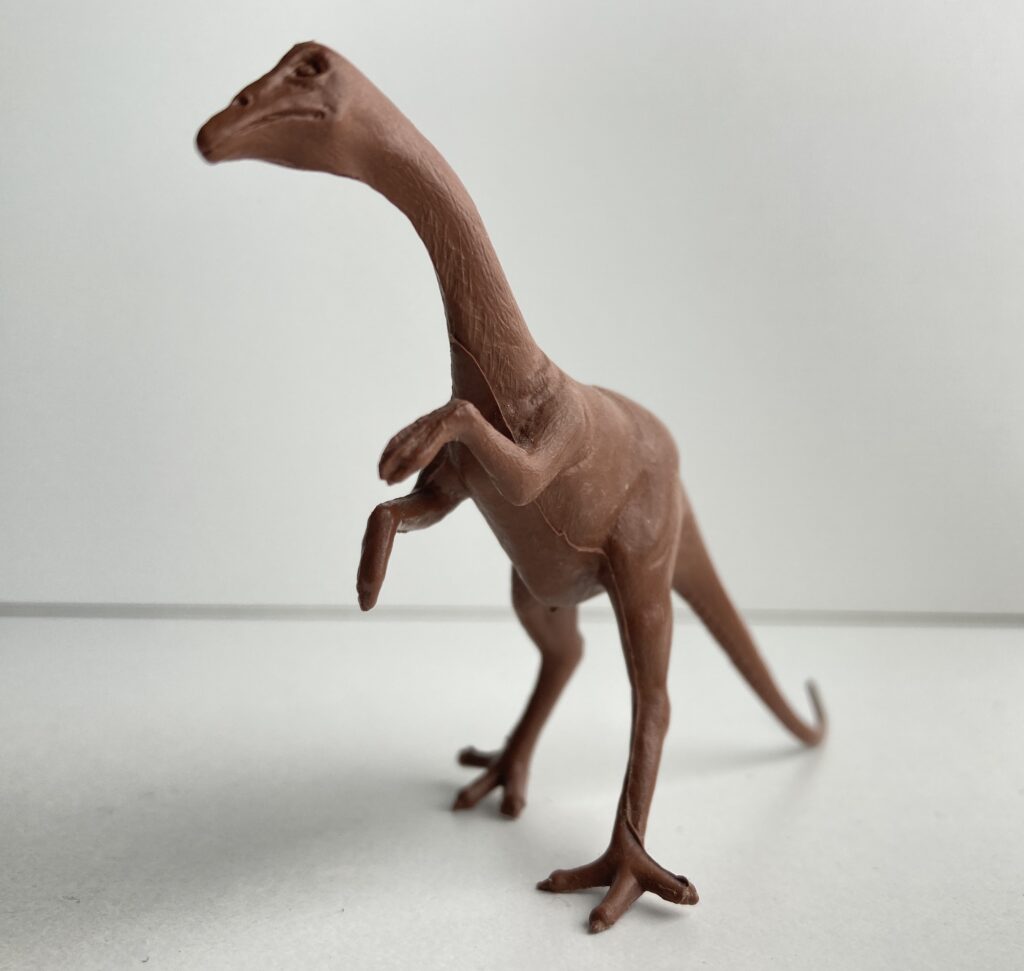
The texture of the skin is more or less smooth all over, with a little bit of fine texture on the neck. These days the sculpture would be decorated by feathers, but that wasn’t the case in the 1960s. Still, there’s something slightly ‘feathery’ about the texture on the neck, although this probably wasn’t intentional. Beyond these historical anatomical issues, Derham created an excellent likeness of a lithe ornithomimid dinosaur, especially when taken in the context of his day.
The name “STRUTHIOMIMUS” is neatly embossed on the left underside of the tail, along with the height “8′ TALL”, written on the right underside of the tail (so upside-down relative to the genus name). We now know that Struthiomimus was closer to 16 ft. long, so this puts this model around a scale of 1/50. The mould lines are clearly visible but they have been positioned to minimise their impact, subtly extending down the spine, and following the contours of the limbs and flanks.
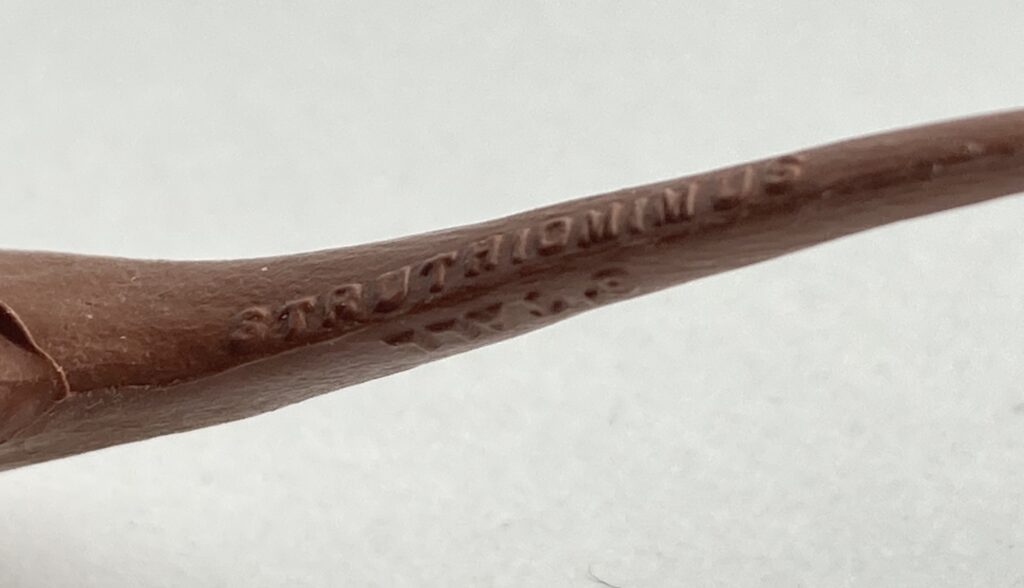
Marx figures were produced in a variety of monochrome colours. This chocolate brown version is particularly satisfying. Monochrome dinosaurs are also represented by the slightly later Invicta toys, a toy line surely inspired to a greater or lesser degree by their Marx forebears.
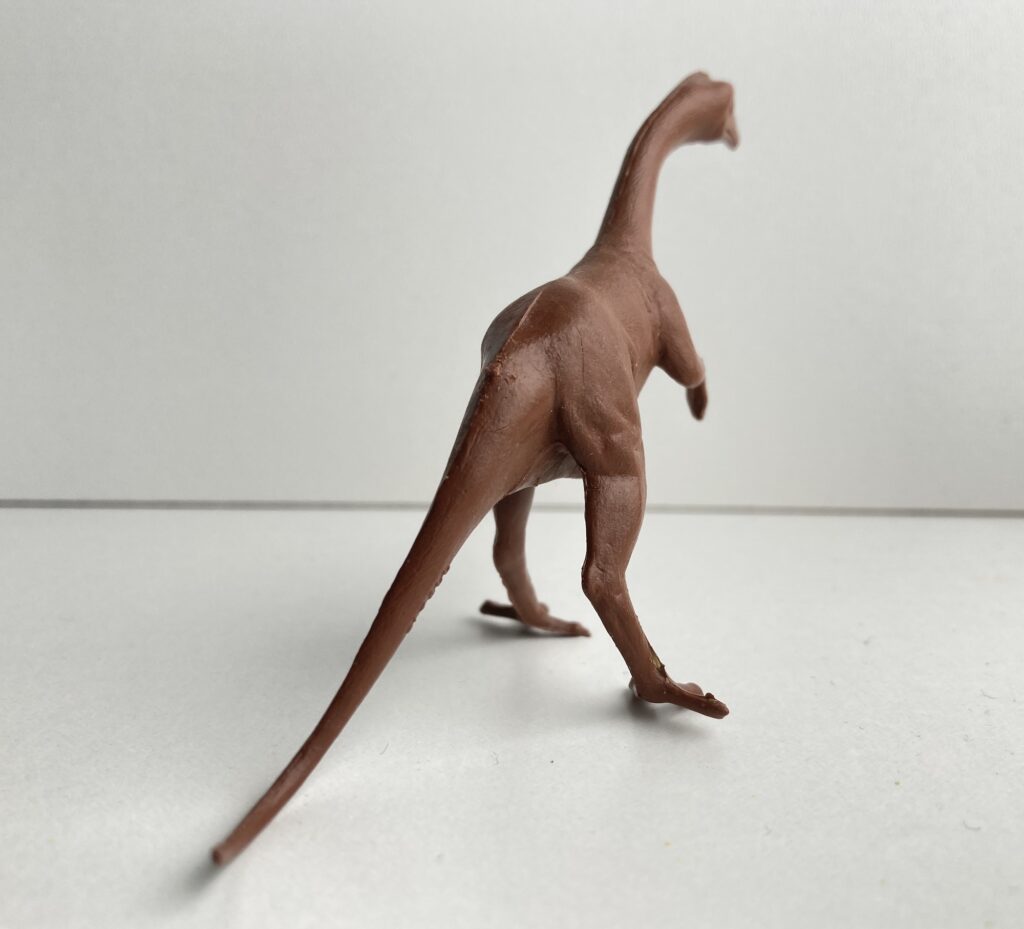
A year after the Marx Ornithomimus was released, Multiple Products Corporation (MPC) released their own Struthiomimus, almost an exact copy. One way to tell the difference is the colours. MPC dinos were made in bright primary colours, which are different to Marx’s more natural tones of grey, tan, seafoam green, or brown. Word on the street (or in Jeffrey Pfeiffer’s incredible book Dinosaur Playsets) is that the second mould group came in swirled grey and metallic green as well. Following MPC’s blatant copy, many other companies followed suit, and echoes of Derham’s Struthiomimus can be found in many colors and sizes in sundry dino dollar bags today. It even appears to have served as the inspiration for a page in a vintage colouring book.
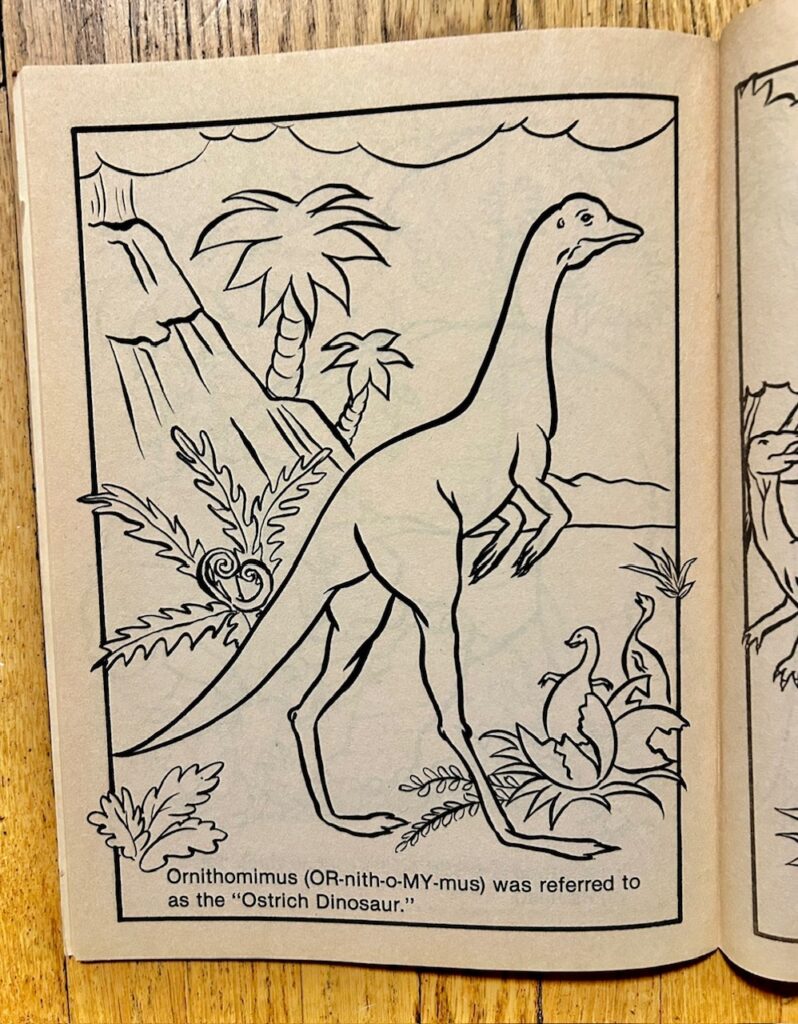
A number of years ago one of the authors (BlueKrono) was lucky enough to come into possession of the deaccessioned original clay Ornithomimus sculpture previously displayed in the Marx Toy Museum of Moundsville, West Virginia.
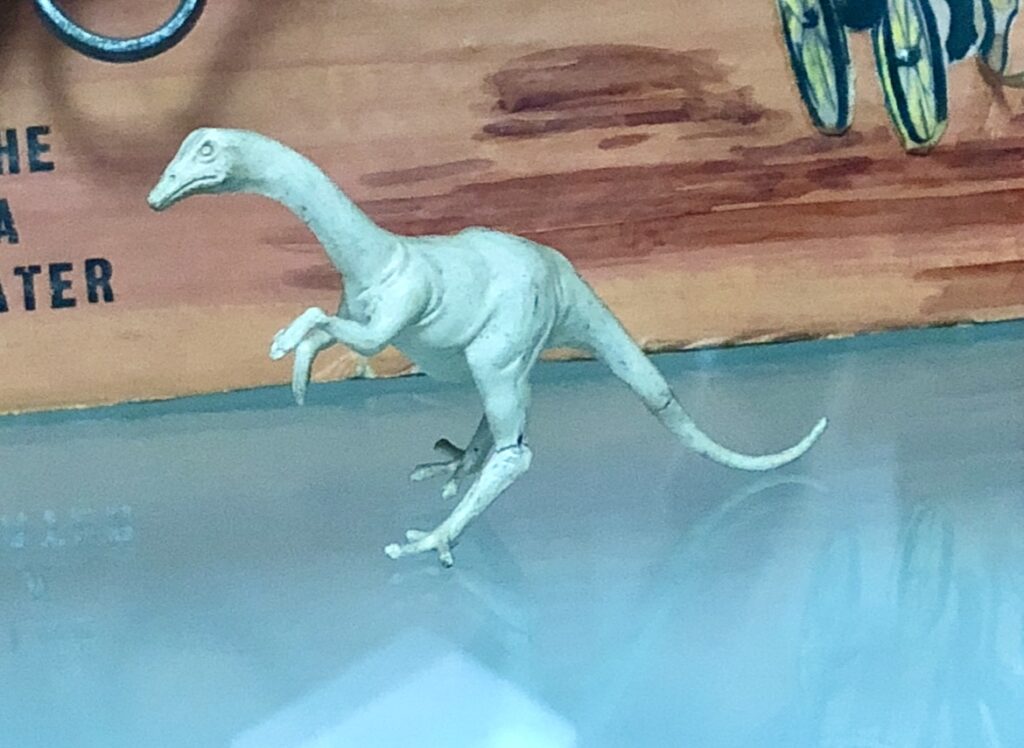
This incredible piece was sculpted by the hand of Phil Derham himself and exhibits sharper details than the plastic Struthiomimus models cast from it. Tiny crosshatch marks can be seen on the clay, and it’s hard to tell if these are tool marks or Derham’s fingerprints, or possibly both. Regrettably, in the decades since it was created it has sustained breakage to the fragile tail and one of its legs, but through the cracks an interior wire can be seen, demonstrating that Derham started his tiny dinosaur sculptures with a metal wire infrastructure.

The owner of the Marx Toy Museum, Francis Turner, described the material as “clay” but it is so smooth and light that it might instead be more akin to plasticine. In any case it is very hard and brittle, with no flexibility like its plastic counterparts.
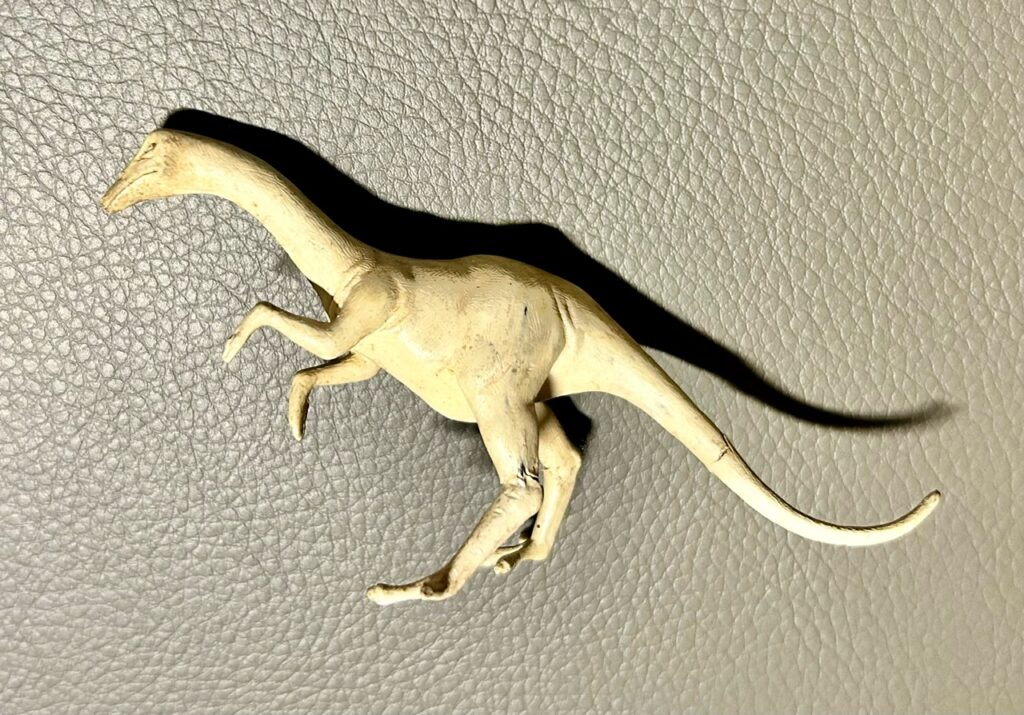
Aside from the sharper surface details the clay model also lacks the seam lines and excess flashing found on the plastic ones. Strangely enough, the writing found on the tail which reads “Struthiomimus” and “8’ tall” is also missing, so we are very curious when and how this was added on, since it wasn’t on the original model.
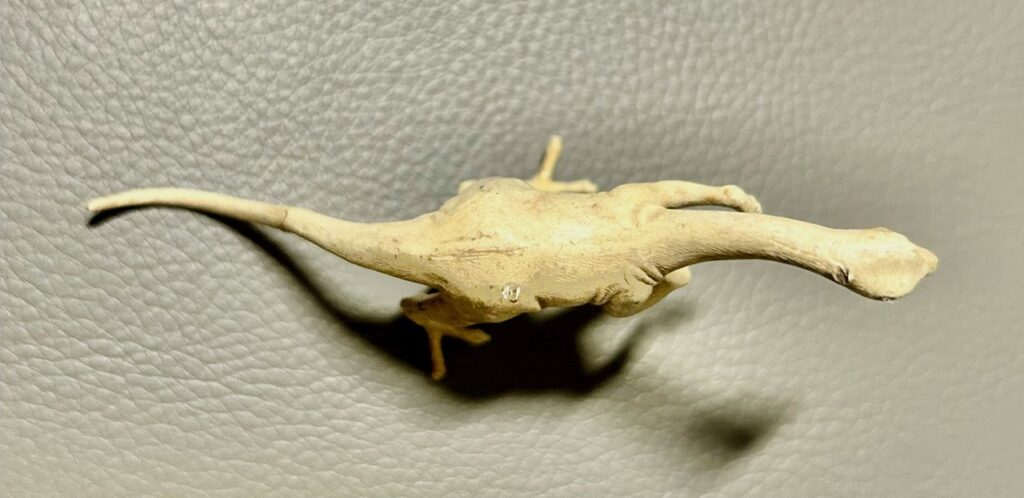
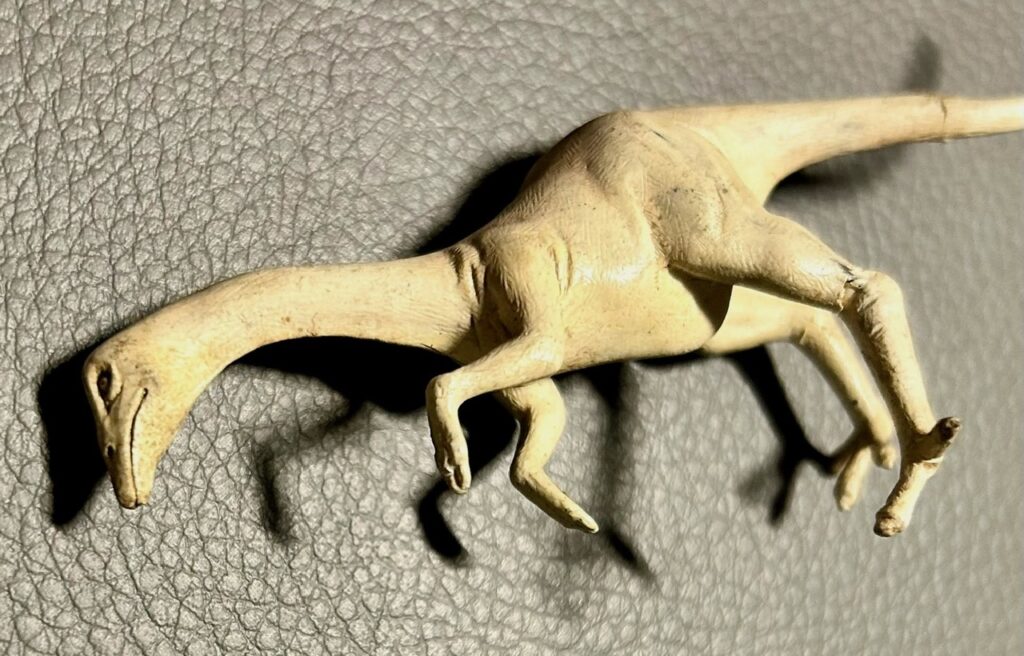
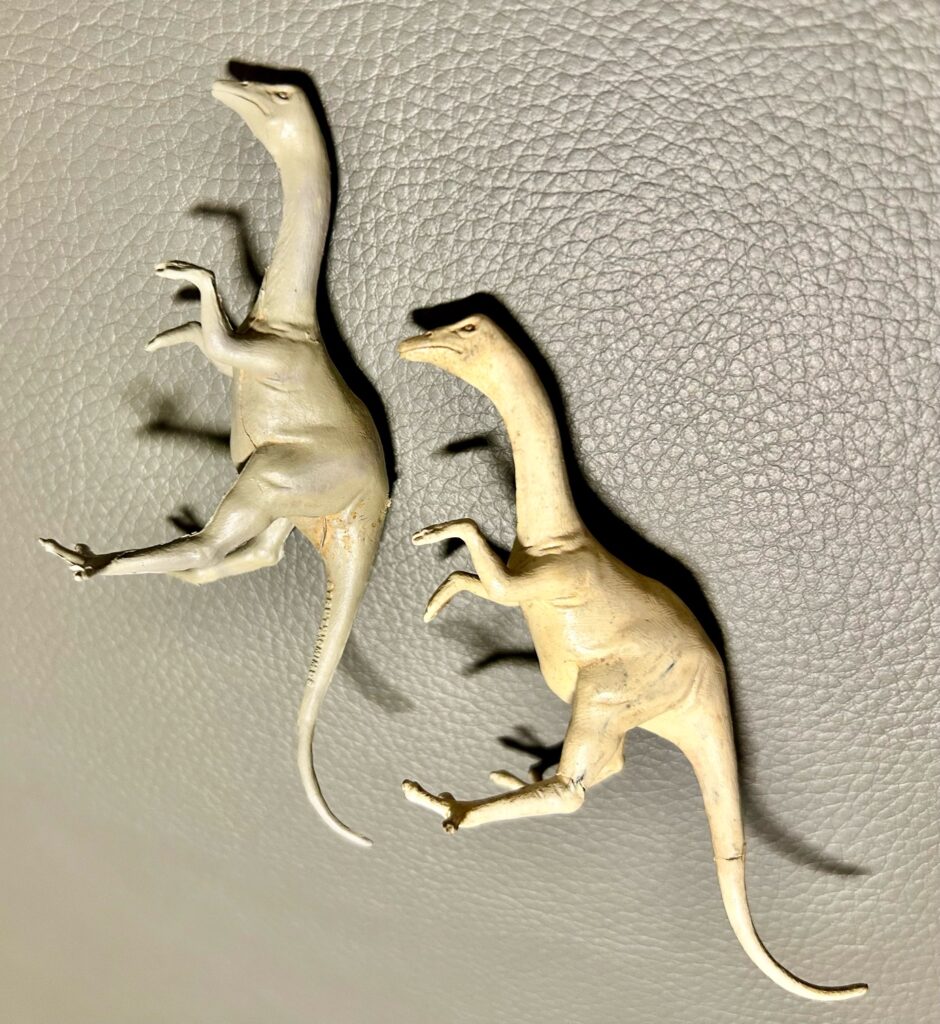
Another interesting fact about the history of this piece comes from Rudolph Zallinger’s daughter Lisa (Zallinger) David. As early as 1963 the Canadian tea company Brooke Bond began releasing small dinosaur cards and Zallinger’s illustrations were featured, including the Oviraptor on which the Marx toy is based.
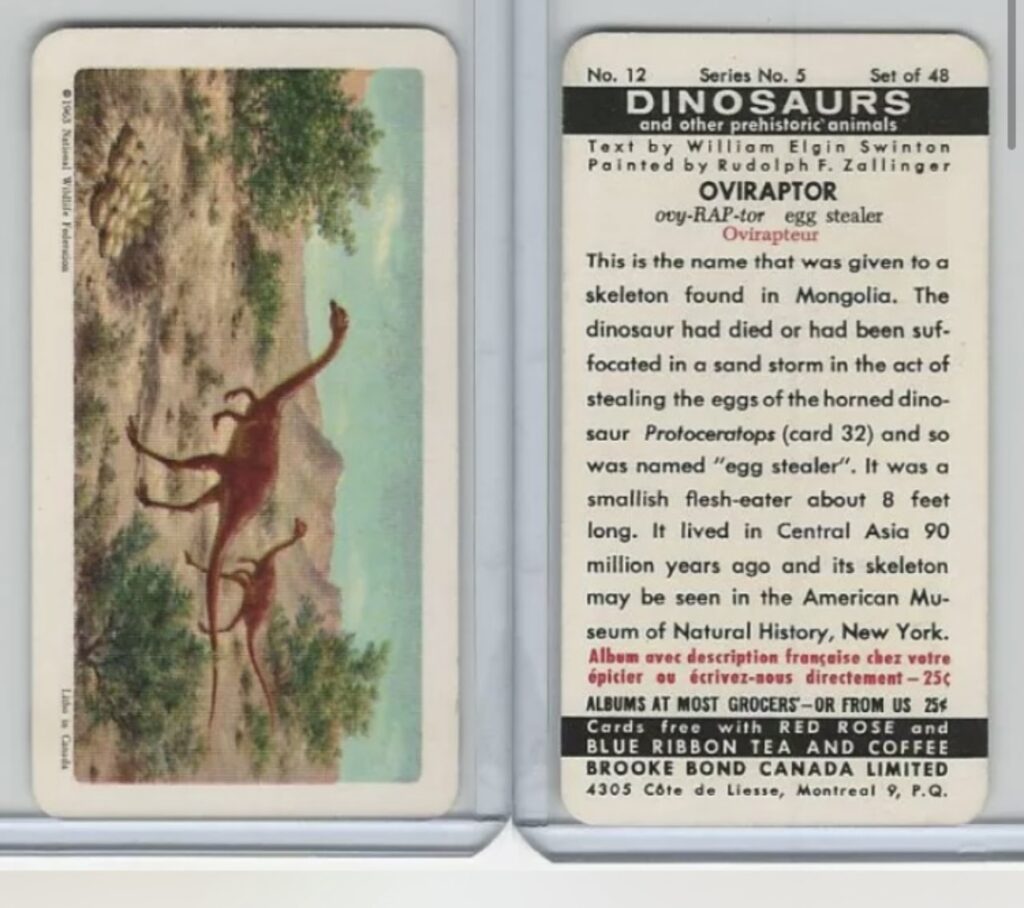
Lisa told us Rudolph had a habit of giving away his original paintings to local dinosaur fans, most of whom were in grade school. She confirmed that the illustration of the Oviraptor was one of the many from the Brooke Bond series that disappeared this way. However, she said the pencil study her father did for the Protoceratops and Oviraptor still resides in her family collection. So, there’s a chance, if these can be dug out in the future, that we may be able to share pictures of the earliest ever ‘incarnation’ of the Marx Struthiomimus.This interesting quirk of dinosaur toy history makes BlueKrono proud to own this piece inspired by the work of a man who was both talented and generous.
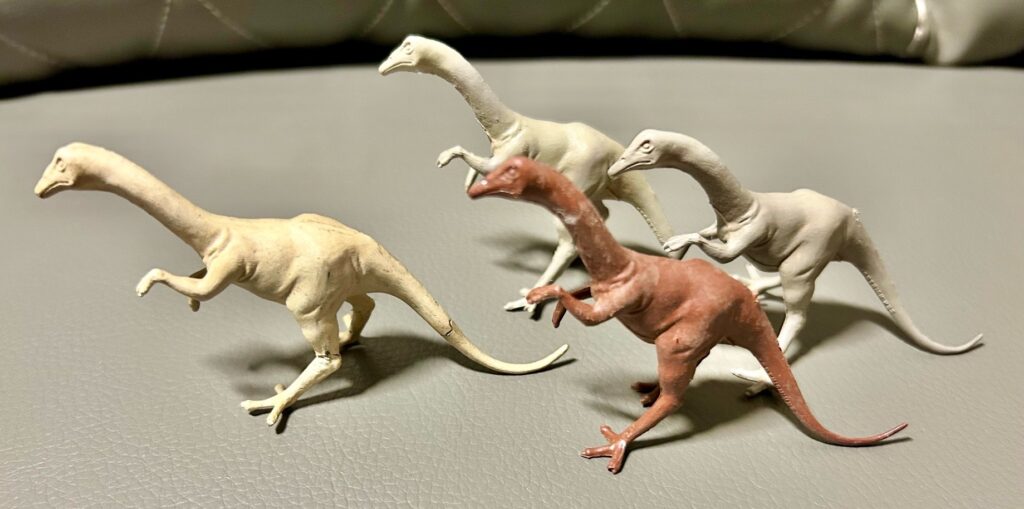
Marx really pulled something special out of the bag with this impressive Struthiomimus sculpture. The only company that rivalled Marx at the time in terms of ambition and attention to detail (with the addition of paint) may have been Starlux, but those toys tend to be brittle and prone to breakage, whereas Marx figures have like this one have clearly stood the test of time. Marx touted his plastic toys as “indestructible” and while that’s not quite true, many survive in the 2020s. The Marx Struthiomimus can be somewhat rarer than other Marx dinos, perhaps due to its slender fragility, but it was mass-produced so despite being out of production for many decades, it is still relatively easy to pin down on Ebay.
There aren’t many Marx figures left to feature on the Dinosaur Toy Blog now so you can anticipate that our Marx review series will be complete soon!
Disclaimer: links to Ebay and Amazon on the DinoToyBlog are affiliate links, so we make a small commission if you use them. Thanks for supporting us!



Thanks all. I poured a lot of research into this one, though it surely took overlong. The next two Marx reviews will be lengthier but coming up soon. That is very interesting Crackington, and proves Jeff right! There seems to always be more to learn about Marx.
What a fantastically researched and enertaining review!
Another classic recorded for the Blog! While not as dramatic as the larger figures, I appreciate the emphasis on how impressive the toy is for its daintyness and finer features.
One of my favorite Marx toys, I also have the chocolate brown one. Great to see a review from you!
Great review guys – loved how you linked up the paleo-art to Phil Derham’s sculpt.
I have a nice dark green version of it, which Jeff Pfeiffer thought may have come from Marx’s Canadian factory. Beautiful vintage figure.